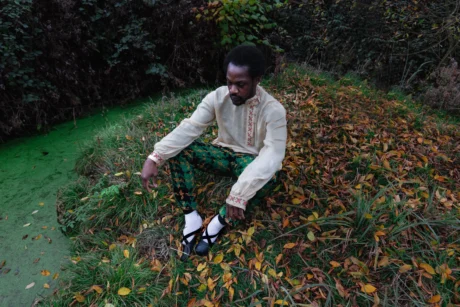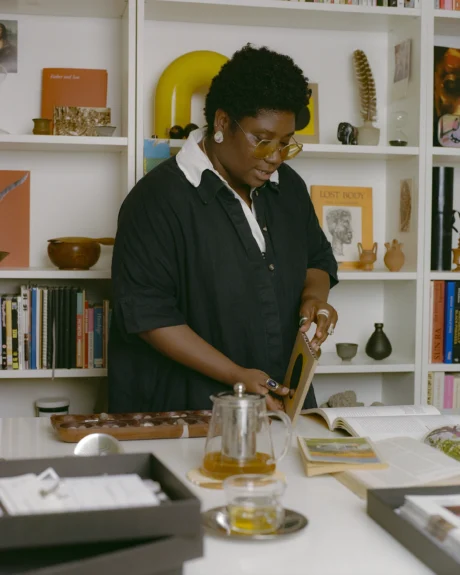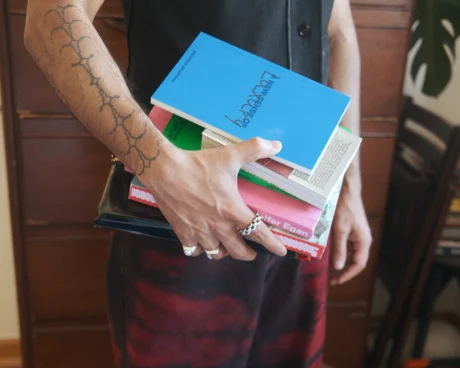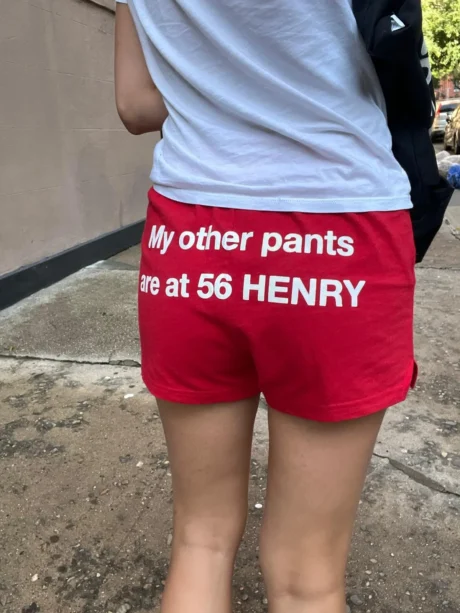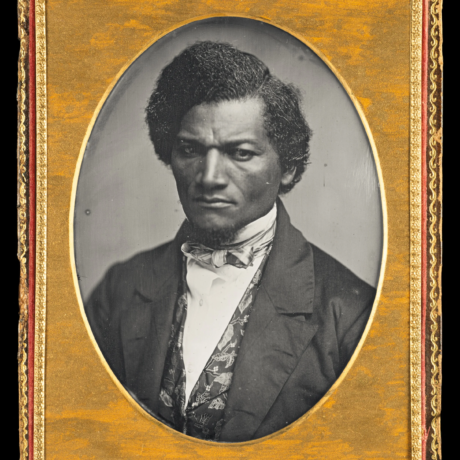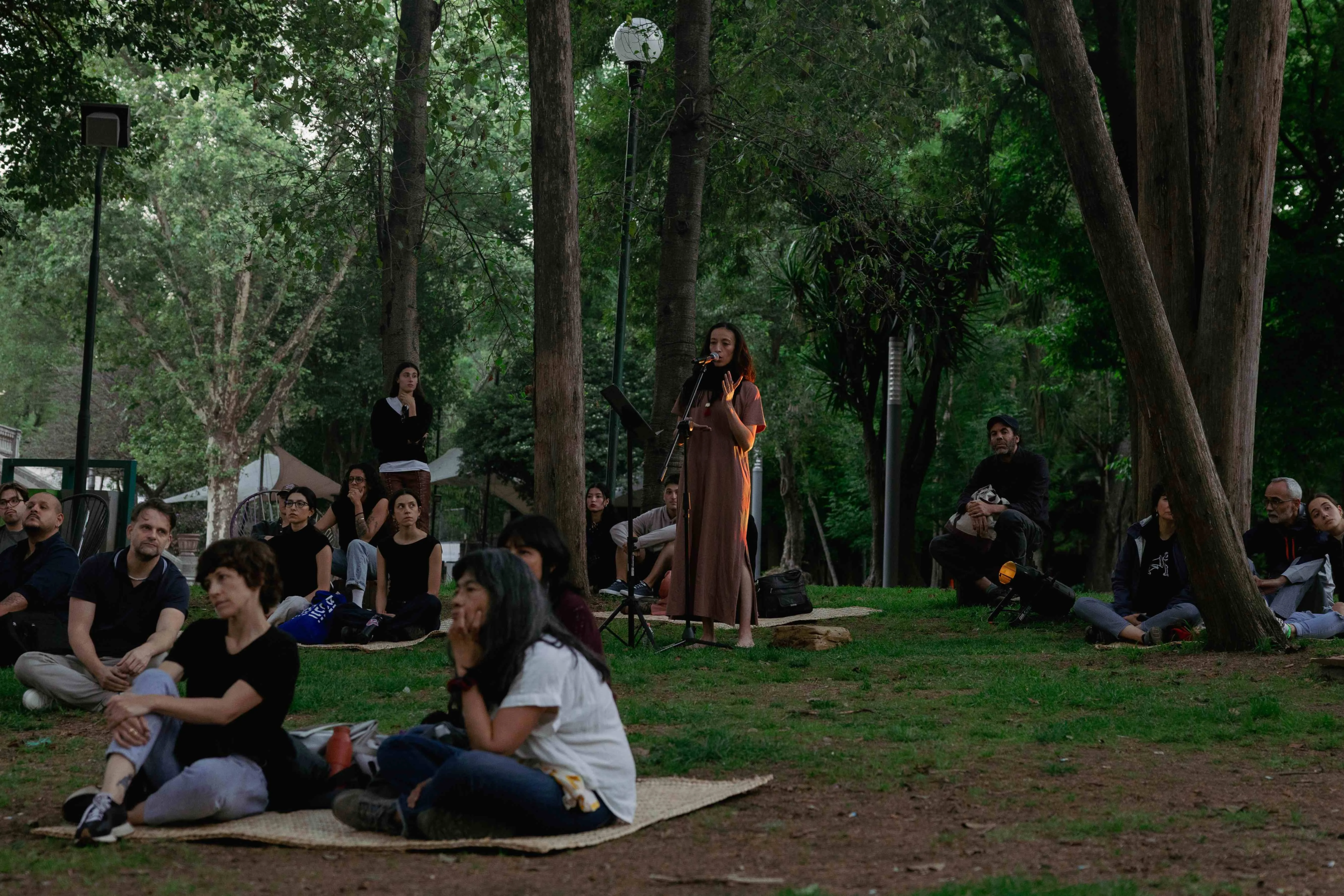
TONO is a performance art festival held in Mexico City and Puebla. Over twenty-four hours at TONO 2025, Karim Kazemi parties with Eartheater, sees several performances and gives incorrect medical advice to fellow attendees.
Tasked by Elephant magazine with writing a recap of TONO—the sprawling video art and performance festival now in its third year across Mexico City and Puebla, bringing international artists to perform alongside local talents—I scrolled through the website trying to decide which 24-hour period I intended to document. My careless reading of daily listings, combined with my fantastical projection of curator Samantha Ozer as some kind virtuosic cultural air traffic controller, convinced me there were multiple performances happening back-to-back at venues requiring multiple metro transfers and a shaman’s blessing to reach at the appointed hour. I pictured myself frantically Ubering from one sector of Mexico City to another, then somehow teleporting 130 kilometers south to Puebla before nightfall. This marathon appealed precisely because it would leave me too exhausted to produce the typical art event social diary—that noxious genre where the writer, as consolation prize for being the most underpaid, underappreciated species in the creative ecosystem, gets to take cracks at everybody, coming out on top as the most perceptive bitch in the room. No, I’d be running on fumes, forced into kindness by my runner’s high. The reality was humbler: most listings were static installations you could see anytime that day, with a single presentation anchoring the programming at night.
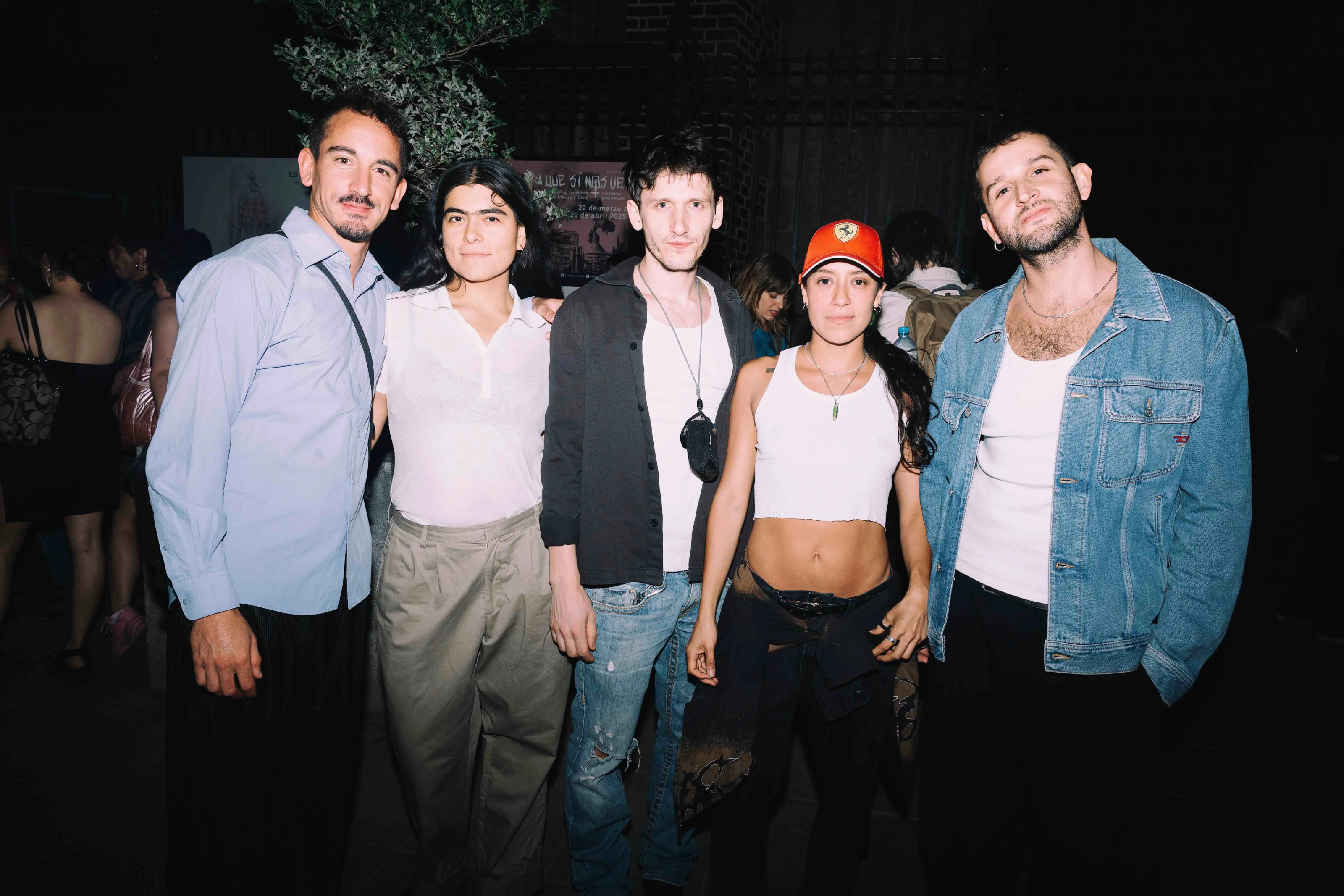
I’d also, embarrassingly, convinced myself the official party was Thursday when it was actually Wednesday—a cognitive lapse possibly induced by the festival’s queer-heavy roster, as if gayness and Thursdays share some cosmic connection that Wednesdays, fundamentally, lack. (Ozer’s curatorial signature exudes the unmistakable energy of someone who’s never met a gay person she didn’t click with.) Needless to say, I missed it. But my friend, the poet Shiv Kotecha, was there — delivering a post mortem, through WhatsApp voice memos, the following day.
Shiv’s dispatch: “Arrived early. Sat around a table with three other faggots in black tank tops and silver jewelry — talking about whales and some shit — and was really enjoying myself. Russian dumplings, herring, mezcal. Drama when the first DJ stormed out in a tizzy, curator chasing after him. Then Klaus Biesenbach entered and said hello.” This last detail sparked genuine FOMO. I long to confront Klaus Biesenbach, the most famous person to have ever blocked me on Instagram, to plead with him: WHAT DID I DO!?
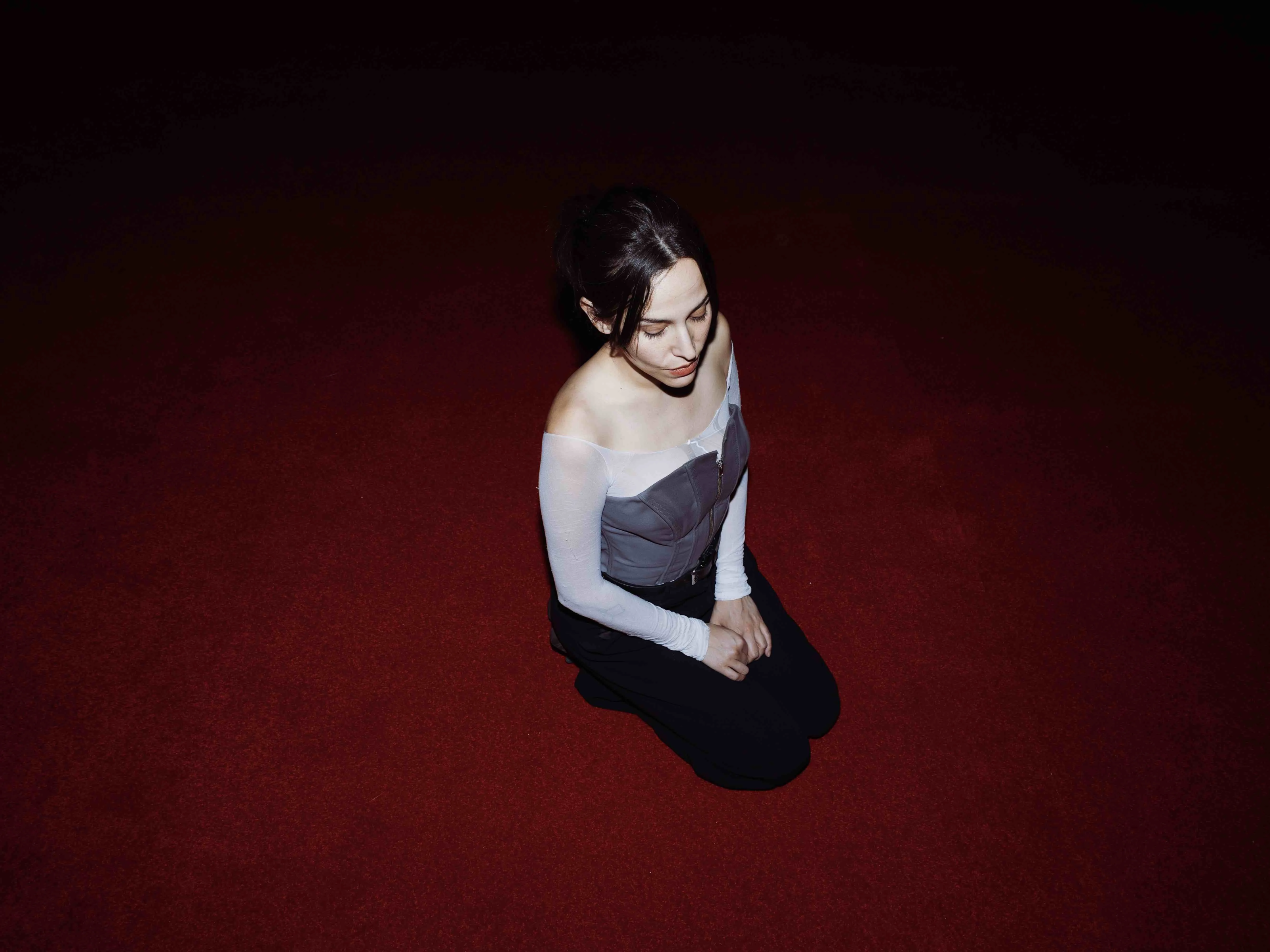
Anyway, it came as no surprise that the party was held at Veri Bari — which friends and I have taken, with fondness, to calling “very boring” — not because there’s anything wrong with it, but because it’s the social black hole none of us can escape, the city’s twenty-million inhabitants apparently capable of supporting exactly one bar where art people gather. For readers of this magazine eager for insider recommendations on Mexico City’s nightlife, here it is, your hot tip, though I hesitate to even write this because: if you’re under forty, work in any creative field, and find yourself visiting our “emerging cultural capital,” you will inevitably end up at Veri Bari anyway. As Mexicans say: “Al final del rio se junta la basura” — at the river’s end, the trash gathers.
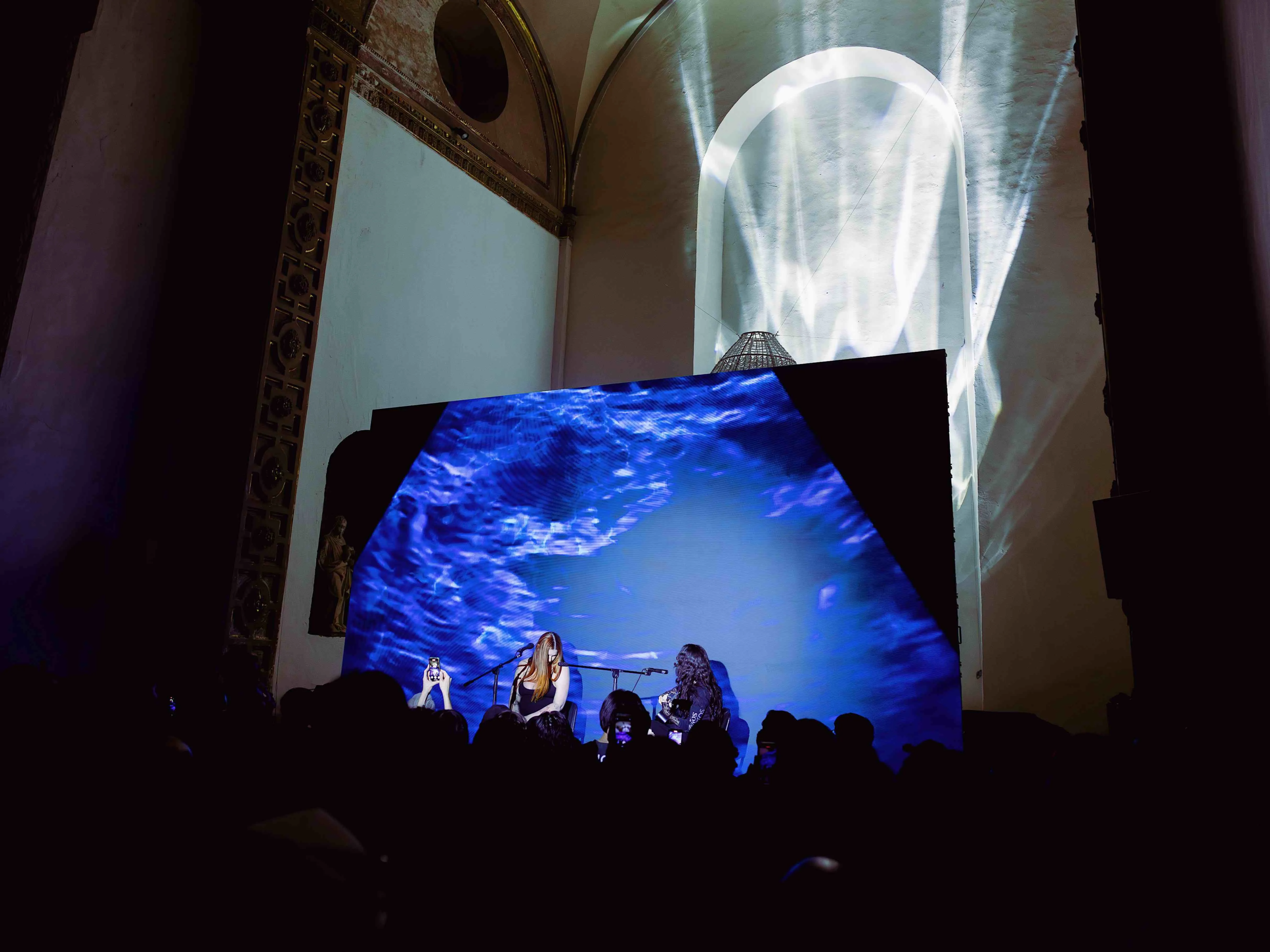
On Friday evening, I made my way to Ex Teresa Arte Actual, a former 17th-century convent steps from the Zócalo, to take in the multimedia performance by Eartheater and Freeka Tet. The vaulted interior had a kind of “hall of reptiles” atmosphere — the air hot and thick with the scent of young bodies and their chosen colognes, the trendy saffron- and clove-laced ones that, at the wrong concentrations, seem like the work of a team of luxury consultants attempting to distill the essence of a bowl of butter chicken. On a big black screen, a five-minute countdown to the performance (billed, somewhat misleadingly, as a “live stream”) blared. As zero neared, the crowd chanted along — half in English, half in Spanish, the numbers tangling together before dissolving into collective groans. The screen had lit up: Eartheater appeared, acoustic guitar in hand, leg propped up on an ottoman, VERY pregnant, harpist and violinist in tow. She launched into song.
People had been hoping for a live show, not something pre-taped, but maybe this was the live stream; the architectural details of her surroundings, the way the sky outside the window glowed with the same blue-black of early evening that I’d walked through on my way there, suggested that the video might’ve been beamed in from elsewhere, some former nun’s cell or prior’s chamber, in the same building. There’s something to be said for playing on an audience’s disappointment, for being a tease, and I appreciated the sense of displacement, the “the-call-is-coming-from-inside-the-house” spookiness this setup generated — like performance pieces by Vito Acconci from the early ‘70s in which he masturbated beneath the floor of a packed gallery, while issuing lewd, disembodied, loudspeaker-amplified remarks.
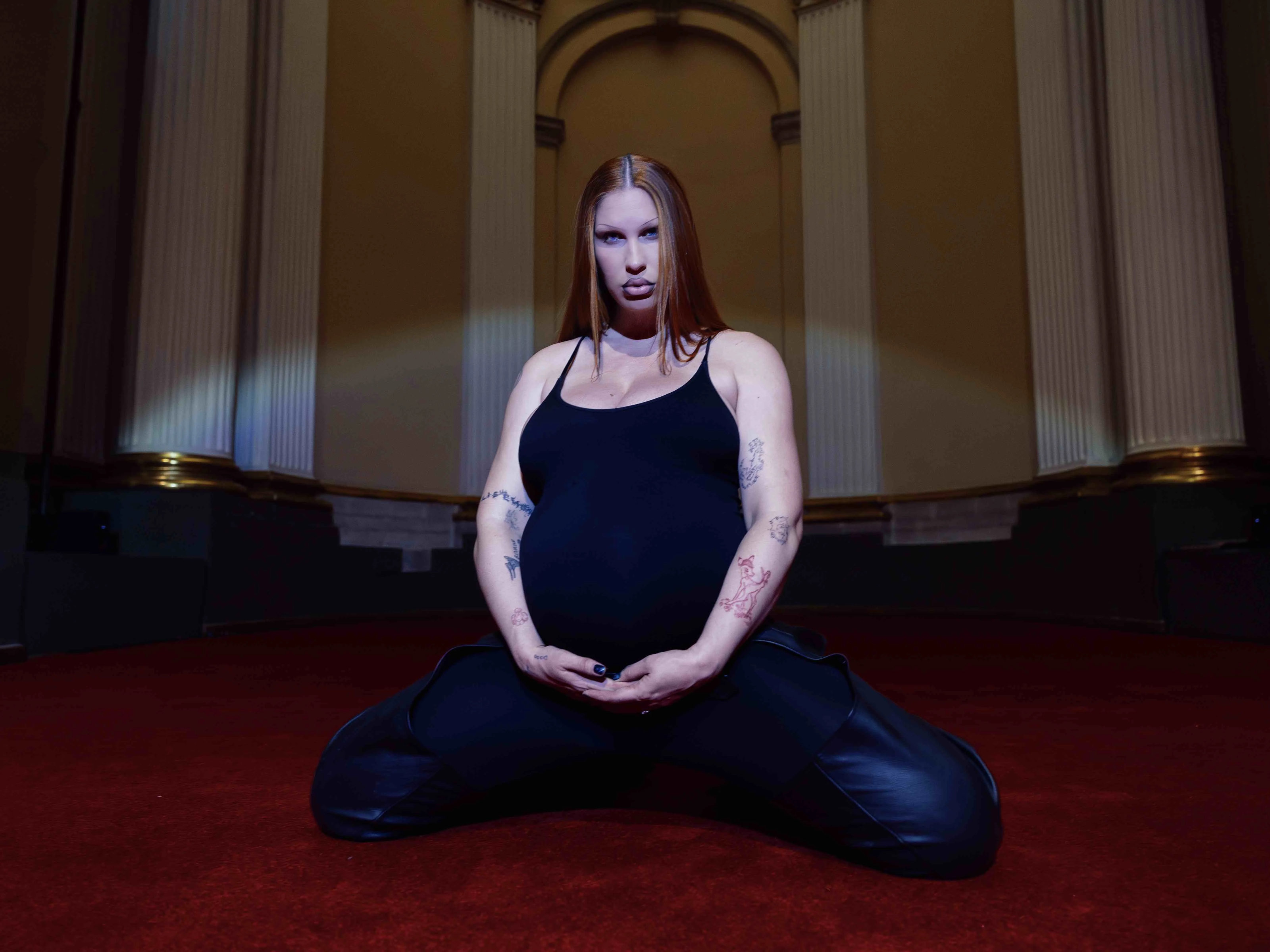
This theory collapsed as soon as the video cut to the musicians playing in front of a sliding glass door, opening onto a porch deck, beyond which lay a vast, upsettingly green lawn — too much grass to be anywhere in Mexico, much too bright outside to have been right now. Someone was wrapped around the porch railing, humping it. Then back to the first shot: she wailed — her water broke, she was giving birth to…a shark? Word trickled through the crowd that someone, who somebody knew, did Eartheater’s makeup today. She was, therefore, definitely here. And she was! She emerged, performed three songs live, and all that we at the back could see was the top of her tight, tight ponytail, black against blue stage lights, in relief. She was sort of giving Claudia Sheinbaum, people agreed — fitting, since we were right across the street from where the president works and, supposedly, sleeps.
My friends and I left a little early, paying it forward for the fans gathered outside as the venue announced a “one-in, one-out” admission policy. We went for drinks, were drinking at a nearby cantina, when “Shark Brain,” Eatheater’s collaboration with Shygirl, which she had debuted live that night at TONO, began streaming, wherever music can be streamed.
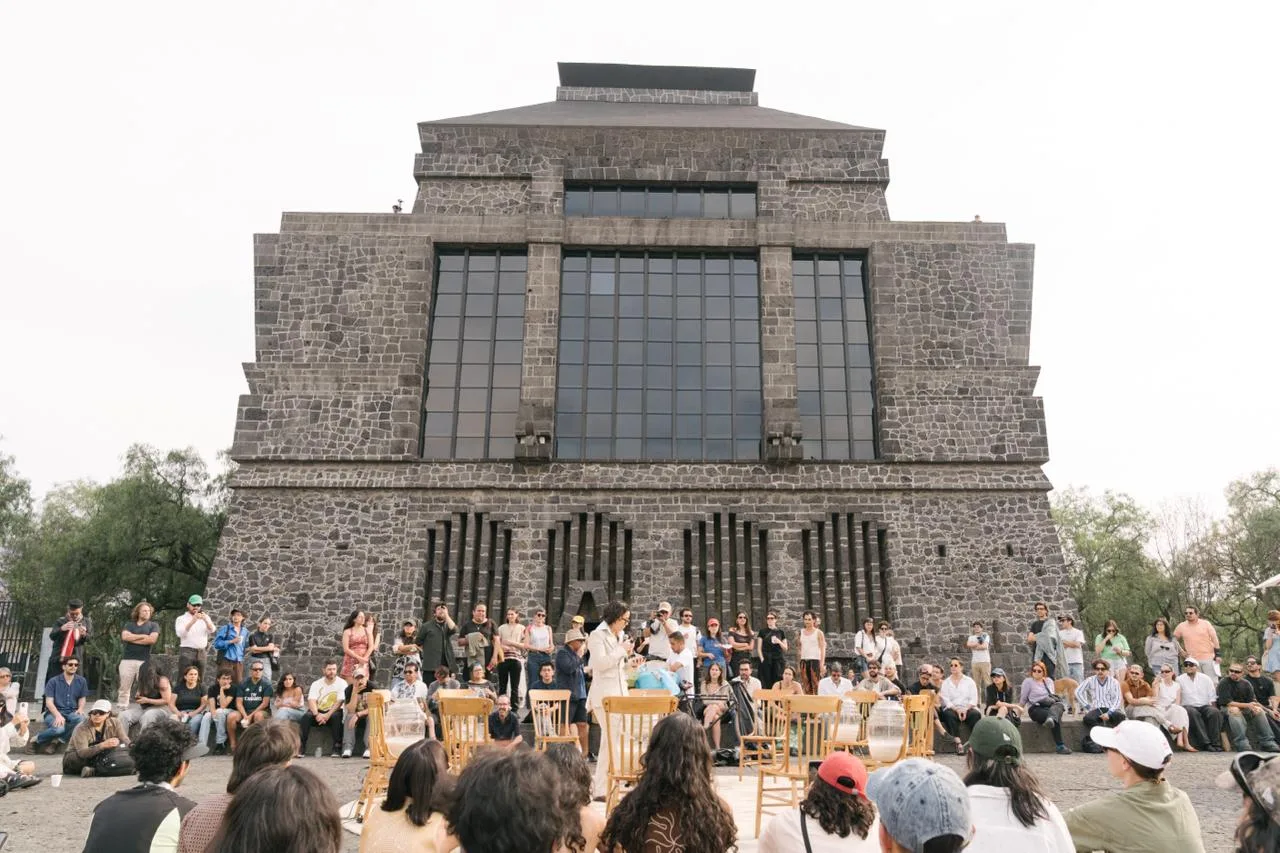
On Saturday afternoon I found myself at Museo Anahuacalli, Diego Rivera’s volcanic stone shrine to pre-Hispanic artifacts, for “Aguas Frescas,” a series of performances staged on and around an installation by artist and fashion designer Bárbara Sánchez-Kane. (The museum sits just far enough from the city’s center to qualify as a day trip. Fittingly, it seems to always be full of couples on their fourth or fifth date.) Eleven identical wooden chairs were arranged in a perfect circle on the museum’s esplanade, all facing inward, alternately holding glass jarras, those ubiquitous street-corner punch bowls, each cradling a non-uniform portion of horchata. Inside each, a metal ladle spun tirelessly, while microphones captured and amplified the resulting tinkle and clang. The choice of beverage, a playful nod to Mexican euphemism for “orgy” — perhaps owing to the two words’ phonetic resemblance, its rich mix of potentially discordant ingredients, or its milky, sediment-flecked, exudative consistency. The ladles, bent at the handle, a subtle iteration of Sánchez-Kane’s hallmark visual motif: a woman’s legs, stilettoed and splayed.
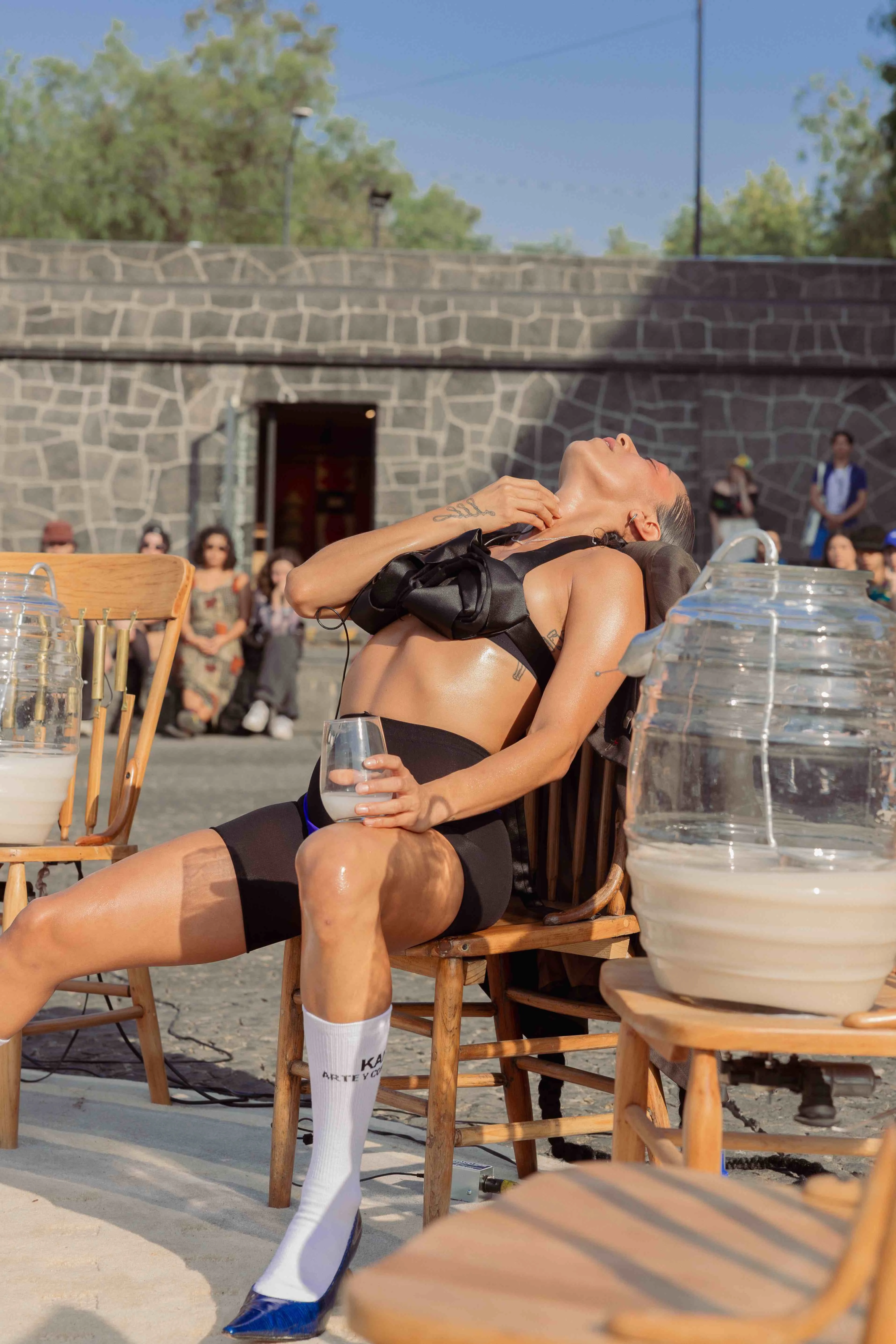
First up was Ariane Pellicer, entering the circle in gleaming pleather pants and a Sánchez-Kane sculptural bodice, sprouting metal wire legs from both front and back. Pellicer’s distinctly inquisitorial mode of delivery — instantly recognizable to anyone who’s seen her as a telenovela villain or as the pearl-clutching mother on La Rosa de Guadalupe, Mexico’s long-running daytime TV morality play, where her daughter’s request for skating shoes sparked the iconic admonition (“You can no longer hide it. You are emo!”) that’s since become a meme — was on perfect display as she delivered a monologue, an extract from a longer text by playwright Ximena Escalante. The ladles responded like mechanical familiars, their pace controlled to match Pellicer’s emotional cadence, reaching peak velocity as she proclaimed (translation mine) that “Clothing is a form of oral sex. It speaks of things that nobody understands. But everyone uses it. Fashion is futile, but sexy!”
In the following act, a woman with legs so long, strong, and perfect they may have been the blueprint for Sánchez-Kane’s insignia, moved silently through a series of what might’ve been yoga poses, contorting her face into expressions of ecstasy and/or agony, wearing a boxy, sort of steampunk business suit, like someone in the throes of a distinctly secular form of exorcism. People were transfixed.
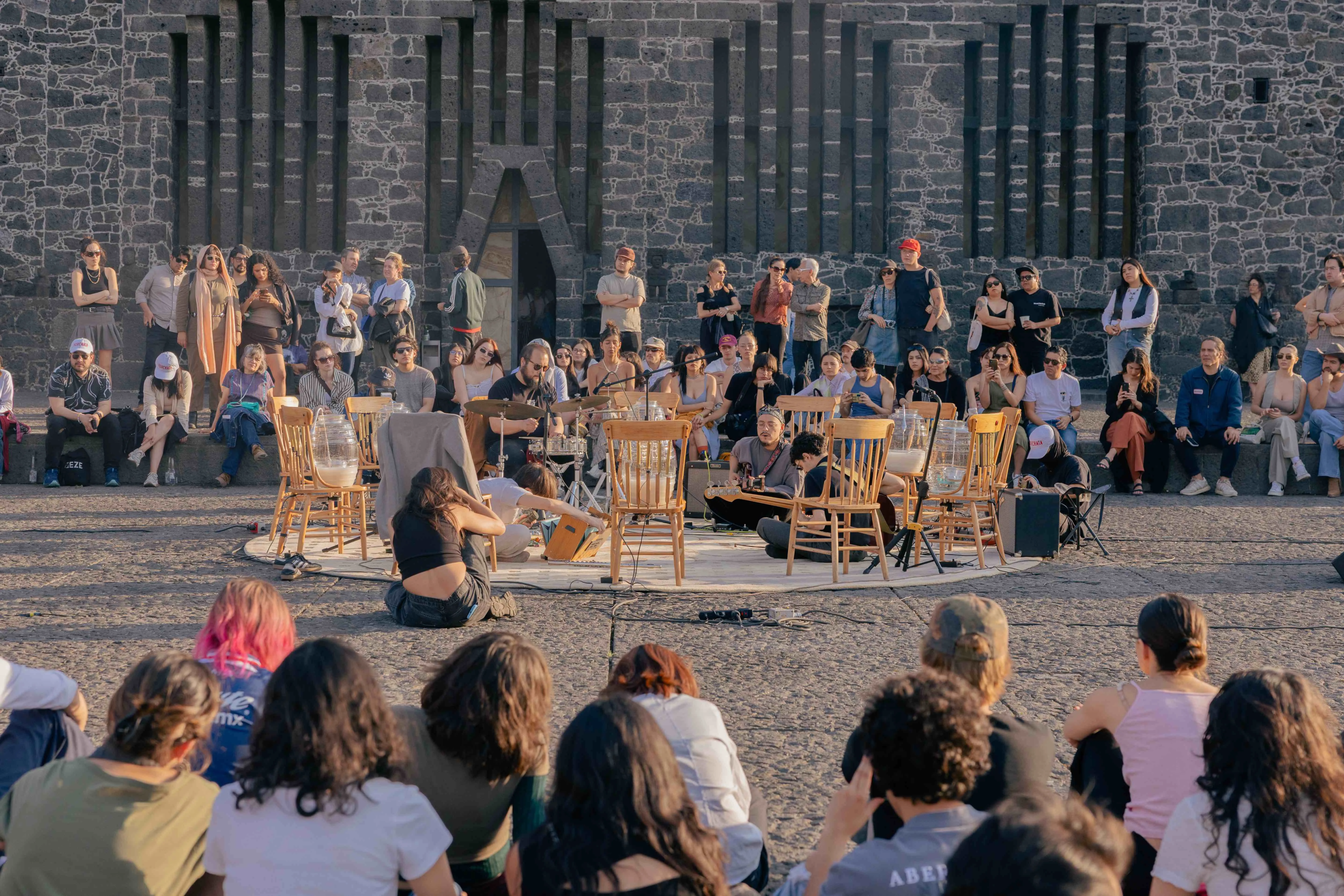
Finally, a musical act, Diles que no me maten, a group of boys in their early twenties set up shop, some of them sitting cross-legged, on the floor. The sound, a hazy, plaintive wash of droning guitars, saxophone, and cymbals scraped with a violin bow, called to mind, or was perhaps an explicit homage to, Talk Talk’s Spirit of Eden. It was very pleasant, and the audience’s attention loosened a bit.
The entire gathering took on the feel of a picnic. I was a little hungover. There had been a partial solar eclipse, which astrologers like to liken to a celestial “power outage,” at 6AM that morning. The usual sharpness of this kind of event, attended by this kind of people—the urgency, the posturing, the jockeying—was absent. The black tezontle we’d all been sitting on radiated heat.
“This is going to give me hemorrhoids,” confided someone I only kind of know.
“Doesn’t heat treat them?” I shot back, half-distracted, and the vibe was so chill and convivial that she didn’t even bother to correct me, despite the fact that I was most definitely wrong.
Written by Karim Kazemi
